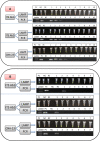Development of Loop-Mediated Isothermal Amplification Assay for Detection of Clinically Significant Members of Acinetobacter calcoaceticus-baumannii Complex and Associated Carbapenem Resistance
- PMID: 34250011
- PMCID: PMC8260673
- DOI: 10.3389/fmolb.2021.659256
Development of Loop-Mediated Isothermal Amplification Assay for Detection of Clinically Significant Members of Acinetobacter calcoaceticus-baumannii Complex and Associated Carbapenem Resistance
Abstract
Background: Acinetobacter calcoaceticus-baumannii (ACB) complex has emerged as an important nosocomial pathogen and is associated with life-threatening infections, especially among ICU patients, including neonates. Carbapenem resistance in Acinetobacter baumannii has emerged globally and is commonly mediated by bla OXA-23. Clinically significant infections with carbapenem-resistant Acinetobacter baumannii (CRAB) are a major concern since therapeutic options are limited and associated mortality is high. Early diagnosis of both the pathogen and resistance is important to initiate the optimal therapy and prevent selection of resistance. In the current study, a loop-mediated isothermal amplification (LAMP) assay was developed for rapid detection of the ACB complex and carbapenem resistance mediated by bla OXA-23. Methodology: Universal LAMP primers were designed for the detection of significant members of the ACB complex and carbapenem resistance targeting the ITS 16S-23S rRNA and bla OXA-23 gene respectively. The optimal conditions for the LAMP assay were standardized for each primer set using standard ATCC strains. The sensitivity of the LAMP assay was assessed based on the limit of detection (LOD) using different DNA concentrations and colony counts. The specificity of LAMP was determined using the non-ACB complex and non-Acinetobacter species. The results of the LAMP assay were compared with those of polymerase chain reaction (PCR). Results: The optimal temperature for the LAMP assay was 65°C, and the detection time varied with various primers designed. Using the ITS Ab1 primer, LODs of LAMP and PCR assays were 100 pg/μl and 1 ng/μl of DNA concentration and 104 cfu/ml and 108 cfu/ml of colony count, respectively. The LAMP assay was 10- and 104-fold more sensitive than PCR using DNA concentration and colony count, respectively. The LAMP assay was found to be specific for clinically important ACB complex species. Significance of the study: The LAMP assay can be applied for early detection of significant species of the ACB complex from clinical samples and their carbapenem-resistant variants. Depending on the emerging pathogen and locally prevalent resistance genes, the LAMP assay can be modified for detection of colonization or infection by various resistant bugs.
Keywords: Acinetobacter calcoaceticus–baumannii (ACB) complex; carbapenem-resistant Acinetobacter baumannii (CRAB); internal transcribing spacer (ITS) 16S–23S rRNA; limit of detection (LOD); loop-mediated isothermal amplification (LAMP) assay; polymerase chain reaction (PCR).
Copyright © 2021 Sharma and Gaind.
Conflict of interest statement
The authors declare that the research was conducted in the absence of any commercial or financial relationships that could be construed as a potential conflict of interest.
Figures




Similar articles
-
Application of LAMP assay for detection of carbapenem-resistant Acinetobacter calcoaceticus-Acinetobacter baumannii complex in ICU admitted sepsis patients: A rapid and cost-effective diagnostic tool.Diagn Microbiol Infect Dis. 2024 Sep;110(1):116398. doi: 10.1016/j.diagmicrobio.2024.116398. Epub 2024 Jun 12. Diagn Microbiol Infect Dis. 2024. PMID: 38908041
-
Rapid detection of Pseudomonas aeruginosa and Acinetobacter baumannii Harboring bla(VIM-2), bla(IMP-1) and bla(OXA-23) genes by using loop-mediated isothermal amplification methods.Ann Lab Med. 2016 Jan;36(1):15-22. doi: 10.3343/alm.2016.36.1.15. Ann Lab Med. 2016. PMID: 26522754 Free PMC article.
-
Rapid detection of Acinetobacter baumannii and molecular epidemiology of carbapenem-resistant A. baumannii in two comprehensive hospitals of Beijing, China.Front Microbiol. 2015 Sep 23;6:997. doi: 10.3389/fmicb.2015.00997. eCollection 2015. Front Microbiol. 2015. PMID: 26441924 Free PMC article.
-
A Label-Based Polymer Nanoparticles Biosensor Combined with Loop-Mediated Isothermal Amplification for Rapid, Sensitive, and Highly Specific Identification of Brucella abortus.Front Bioeng Biotechnol. 2021 Nov 18;9:758564. doi: 10.3389/fbioe.2021.758564. eCollection 2021. Front Bioeng Biotechnol. 2021. PMID: 34869267 Free PMC article. Review.
-
Carbapenem-resistant Acinetobacter baumannii and Ventilator-associated Pneumonia; Epidemiology, Risk Factors, and Current Therapeutic Approaches.J Res Pharm Pract. 2024 Dec 23;13(2):33-40. doi: 10.4103/jrpp.jrpp_50_24. eCollection 2024 Apr-Jun. J Res Pharm Pract. 2024. PMID: 39830948 Free PMC article. Review.
Cited by
-
Current Methods for Reliable Identification of Species in the Acinetobacter calcoaceticus-Acinetobacter baumannii Complex.Microorganisms. 2025 Aug 4;13(8):1819. doi: 10.3390/microorganisms13081819. Microorganisms. 2025. PMID: 40871323 Free PMC article. Review.
-
Carbapenem-resistant Acinetobacter baumannii: A challenge in the intensive care unit.Front Microbiol. 2022 Nov 10;13:1045206. doi: 10.3389/fmicb.2022.1045206. eCollection 2022. Front Microbiol. 2022. PMID: 36439795 Free PMC article. Review.
-
Next-Gen Nano Biosensor Technologies to Monitor Carbapenem Resistance for Personalized Medicine.Indian J Microbiol. 2025 Mar;65(1):277-296. doi: 10.1007/s12088-024-01337-z. Epub 2024 Jun 20. Indian J Microbiol. 2025. PMID: 40371034
-
Comparison of loop-mediated isothermal amplification, multiplex PCR, and REP- PCR techniques for identification of carbapenem-resistant Acinetobacter baumannii clinical isolates.Iran J Microbiol. 2023 Oct;15(5):654-664. doi: 10.18502/ijm.v15i5.13871. Iran J Microbiol. 2023. PMID: 37941880 Free PMC article.
-
An integrative review on the risk factors, prevention, and control strategies for carbapenem-resistant Acinetobacter baumannii colonization in critically ill patients.Front Microbiol. 2025 Jan 10;15:1519906. doi: 10.3389/fmicb.2024.1519906. eCollection 2024. Front Microbiol. 2025. PMID: 39867493 Free PMC article. Review.
References
-
- Abdullahi U. F., Naim R., Taib W. R. W., Saleh A., Muazu A., Aliyu S., et al. (2015). Loop-Mediated Isothermal Amplification (LAMP), an Innovation in Gene Amplification: Bridging the Gap in Molecular Diagnostics; A Review. Ind. J. Sci. Tech. 8, 1–12. 10.17485/ijst/2015/v8i17/55767 - DOI
-
- Ahmad A., Iram S., Hussain S., Yusuf N. W. (2017). Diagnosis of Paediatric Sepsis by Automated Blood Culture System and Conventional Blood Culture. J. Pak Med. Assoc. 67 (2), 192–195. - PubMed
-
- Ahn S. J., Baek Y. H., Lloren K. K. S., Choi W. S., Jeong J. H., Antigua K. J. C., et al. (2019). Rapid and Simple Colorimetric Detection of Multiple Influenza Viruses Infecting Humans Using a Reverse Transcriptional Loop-Mediated Isothermal Amplification (RT-LAMP) Diagnostic Platform. BMC Infect. Dis. 19 (1), 676. 10.1186/s12879-019-4277-8 - DOI - PMC - PubMed
-
- Akrami F., Namvar A. E. (2019). Acinetobacter Baumannii as Nosocomial Pathogenic Bacteria. Mol. Genet. Microbiol. Virol. 34 (2), 84–96. 10.3103/S0891416819020046 - DOI
LinkOut - more resources
Full Text Sources
Molecular Biology Databases

